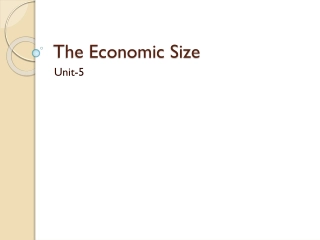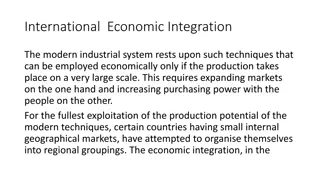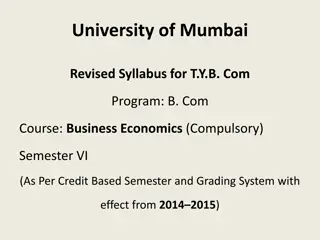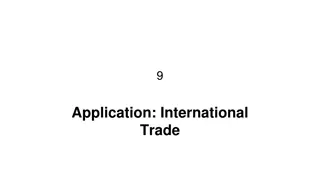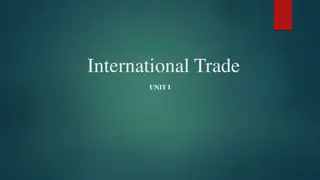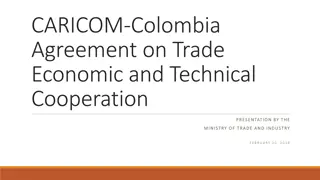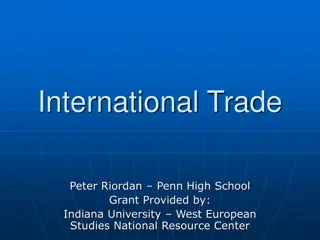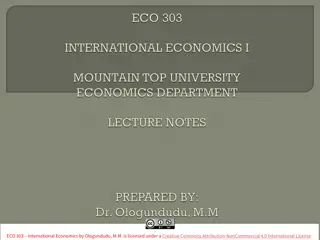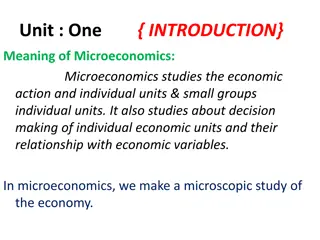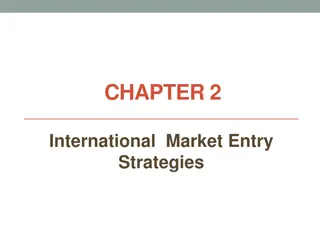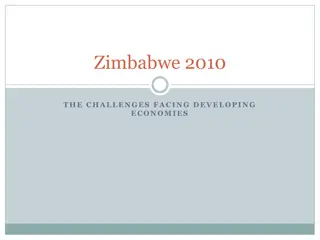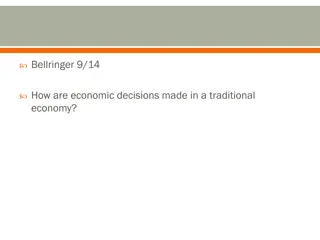The New Trade Theory and Economies of Scale in International Trade
The New Trade Theory, emerged in the 1970s, challenges traditional trade theories by emphasizing the role of increasing returns and economies of scale in international trade. It introduces the concept of industrial organization and imperfect competition to explain how countries trade not only based on resource endowments but also on specialization advantages. Economies of scale provide cost advantages to large firms, leading to a market structure characterized by specialization and efficiency. First-mover advantages are highlighted as barriers to entry in industries where economies of scale play a crucial role.
Download Presentation

Please find below an Image/Link to download the presentation.
The content on the website is provided AS IS for your information and personal use only. It may not be sold, licensed, or shared on other websites without obtaining consent from the author. Download presentation by click this link. If you encounter any issues during the download, it is possible that the publisher has removed the file from their server.
E N D
Presentation Transcript
THE NEW TRADE THEORY
Emerged in the 1970s by a number of economists Countries do not necessarily specialize and trade solely to take advantage of their differences in resource endowments or technology They also trade because of increasing returns that makes specialization advantageous in some industries New trade theorists introduce industrial organization view into trade theory and include real-life imperfect competition in international trade Argue that because of economies of scale, there are increasing returns to specialization in many industries
Economies of Scale and Economies of Scale and International Trade: International Trade: Definitions: Definitions: Economies of Scale Economies of Scale: Reduction of average cost as a result of increasing the output Increasing Returns Increasing Returns: a unit increase in inputs results in more than one unit increase in output Economies of scale Economies of scale is an important source of increasing returns to specialization New Trade Theory New Trade Theory supports the Comparative Advantage theory by identifying economies of scale as an important source of comparative advantage.
Domestic market may not be big enough to realize economies of scale for certain products Ex: Ex: the aerospace industry dominated by Boeing and Airbus How do they achieve economies of scale? First First- -mover Advantage: mover Advantage: New Trade Theory suggests that a country may predominate in the export of a good simply because it was lucky enough to have one or more firms among the first to produce that good First mover s ability to benefit from increasing returns creates a barrier to entry Ex: Microsoft operating systems, Apple s iPod, Google, Ex: Microsoft operating systems, Apple s iPod, Google, etc. etc.
Economies of Scale and Market Economies of Scale and Market Structure Structure How international trade take place? How international trade take place? When there is economies of scale, large firms have cost advantage over small ones and lead to imperfectly competitive market structure ( (ACLarge Each country specializes in producing a restricted range of goods taking advantage of economies of scale Helps them to produce these goods more efficiently than if tried to produce everything by itself Specialized economies trade with each other, making possible to consume the full range of goods (variety of consumption) ACLarge < < ACSmall ACSmall) )
Theory of Imperfect Competition Theory of Imperfect Competition Characteristics Characteristics A few major producers Differentiated products Firm is a price setter not price taker Firms can sell more only by reducing their prices (downward slopping demand curve)
Monopolistic Competition and Trade Monopolistic Competition and Trade In autarky, variety of goods and scale of production are constrained by size of the market Trade increases market size Each country specializes in a narrower range of products Trade offers mutual gain when countries do not differ in resources or technologies Trade makes available variety of goods to the consumers of each country
Economies of Scale and Comparative Economies of Scale and Comparative Advantage Advantage What will be the pattern of trade that results from the What will be the pattern of trade that results from the economies of scale? economies of scale? Two countries Japan and India Japan capital abundant Two products Steel and Rice Suppose Steel is a monopolistic competitive sector (each firm s product is differentiated from others) Japan will be still the net exporter of Steel and importer of Rice
Intra and Inter Industry Trade Intra and Inter Industry Trade Suppose, Steel producers in India produces product different from that of Japan s Steel producers Some Japan consumers prefer Indian varieties So, Japan import as well as export within Steel sector Trade in monopolistic competition model consists of two parts:- Intra-industry trade two-way trade within a sector Inter-industry trade trade between two sectors
Pattern of Trade Inter-industry trade: (Steel for Rice) reflects comparative advantage or H-O Theorem Intra-industry trade (Steel for Steel) depends on economies of scale creating increasing returns due to specialization within the industry The pattern of intra-industry trade is unpredictable The relative importance of intra-industry and interindustry trade depends on how similar countries are
Why Intra Why Intra- -industry trade matters? industry trade matters? About of world trade consists of intra-industry trade Countries are becoming increasingly similar in their level of technology and availability of capital and skilled labour Allows countries to benefit from larger markets More prevalent between countries that are similar in relative factor supplies (capital-labour ratios), skill levels and so on.
Dumping Dumping An important consequence of imperfect competition on international trade Firms do not necessarily charge the same price for goods that are exported and those that are sold to domestic buyers known as price discrimination Dumping the most common form of price discrimination in international trade A pricing practice in which a firm charges a lower price for exported goods than for the same goods sold domestically Major reason: differences in the responsiveness (elasticity) of sales to price in the export and domestic markets


